- Relive the Little Delta hunts
- St. Charles insights on archery
- Every copy is signed by the legend
-
Sale!Out of stock
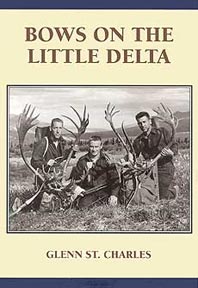 Product Description: Glenn St. Charles at his absolute best. Relive the Little Delta hunts of Glenn St. Charles, Fred Bear and friends as they hunt the pristine Alaskan back country back in the late `50's. Over eighty years of history, hunts, action and the St. Charles philosophy. Glenn relives it all, shedding light on and adding insight to the history of traditional archery in this country. Where we came from to where we are today and everything in between. The second of only two books designated by the Pope and Young club for inclusion in their "Quiver Series". More than 400 pages with 200+ photos, This book is hardcover and all copies are signed by the legend himself! Don't miss this opportunity to own such an incredible book. There are only a limited number of signed copies left so order today!
Product Description: Glenn St. Charles at his absolute best. Relive the Little Delta hunts of Glenn St. Charles, Fred Bear and friends as they hunt the pristine Alaskan back country back in the late `50's. Over eighty years of history, hunts, action and the St. Charles philosophy. Glenn relives it all, shedding light on and adding insight to the history of traditional archery in this country. Where we came from to where we are today and everything in between. The second of only two books designated by the Pope and Young club for inclusion in their "Quiver Series". More than 400 pages with 200+ photos, This book is hardcover and all copies are signed by the legend himself! Don't miss this opportunity to own such an incredible book. There are only a limited number of signed copies left so order today! -
Sale!Out of stock
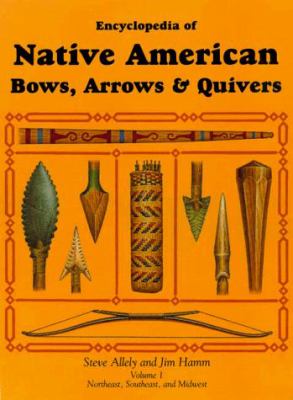 Product Description: Native Americans and their elegant weapons have long held a fascination for archers, history buffs, collectors, and anyone who appreciates traditional skills. From museums and private collections around the world the exceptional Indian archery pieces from the eastern North American tribes such as the Mohegan, Mohawk, Cherokee, Seminole, Chippewa, and Winnebago are brought together in one book. Almost a hundred historic bows, scores of arrows, and more than a dozen quivers from thirty-eight tribes are illustrated. Beautifully detailed full-page pen and ink drawings give dimensions, decorations, and construction details. Hardcover, 135 pages, 8 1/2 x 11, Profusely illustrated.
Product Description: Native Americans and their elegant weapons have long held a fascination for archers, history buffs, collectors, and anyone who appreciates traditional skills. From museums and private collections around the world the exceptional Indian archery pieces from the eastern North American tribes such as the Mohegan, Mohawk, Cherokee, Seminole, Chippewa, and Winnebago are brought together in one book. Almost a hundred historic bows, scores of arrows, and more than a dozen quivers from thirty-eight tribes are illustrated. Beautifully detailed full-page pen and ink drawings give dimensions, decorations, and construction details. Hardcover, 135 pages, 8 1/2 x 11, Profusely illustrated. -
Sale!
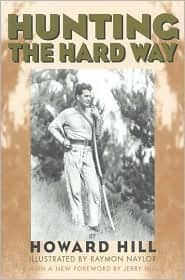 Product Description: Illustrated by Raymond Naylor. With a new foreword by Jerry Hill Hunting the Hard Way is considered by many to be the most sought-after archery title of all time. In this book, Hill recounts his thrilling stories about hunting wildcats, buffalo, mountain sheep, wild boar, alligator, deer, and small game with bow and arrow. Hill devoted a lifetime to the promotion of archery until his death in 1975. His phenomenal technique and his magnificent courage set him apart from the rest of the archery field. His bow work is featured in the classic films Robin Hood, They Died with Their Boots On, and Dodge City. Softcover, 318 pages
Product Description: Illustrated by Raymond Naylor. With a new foreword by Jerry Hill Hunting the Hard Way is considered by many to be the most sought-after archery title of all time. In this book, Hill recounts his thrilling stories about hunting wildcats, buffalo, mountain sheep, wild boar, alligator, deer, and small game with bow and arrow. Hill devoted a lifetime to the promotion of archery until his death in 1975. His phenomenal technique and his magnificent courage set him apart from the rest of the archery field. His bow work is featured in the classic films Robin Hood, They Died with Their Boots On, and Dodge City. Softcover, 318 pages -
Sale!Out of stock
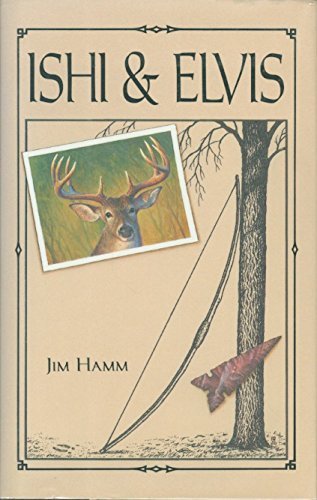 Product Description: Reviews of Ishi and Elvis: "Conservationists and general readers will enjoy this marvelous book. Hamm is a writer to watch.-- Review of Texas Books. "A wonderful change from the normal hunting stories. Hamm has taken outdoor writing to a new level."-- Traditional Bowhunter Magazine. "Wholeheartedly recommended." --New Hampshire Wildlife. Hardcover, illustrated by Steve Allely,
Product Description: Reviews of Ishi and Elvis: "Conservationists and general readers will enjoy this marvelous book. Hamm is a writer to watch.-- Review of Texas Books. "A wonderful change from the normal hunting stories. Hamm has taken outdoor writing to a new level."-- Traditional Bowhunter Magazine. "Wholeheartedly recommended." --New Hampshire Wildlife. Hardcover, illustrated by Steve Allely, -
Sale!Out of stock
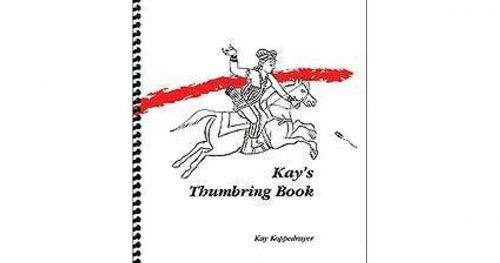 Product Description: Though considered an essential component of archery tackle in many parts of the world, the thumbring was until recently virtually unknown by western archers. "One of the effects of a thumbring is to help redristribute some of the pressure experienced when drawing a bow. No matter which style of releases is used - three-fingered release, thumbring, pinch draw-a heck of a lot of the pressure weight of the bow is concentrated in the small angle of the string just prior to release. At a hefty bow weight, say sixty, eighty, one-hundred pounds, you're going to want some relief. That's why most people wear finger tabs or a shooting glove. The thumbring serves the same purpose." Kay Droppedrayer This work • recovers some of the history of the archer’s ring • discusses the purposes and functions of the thumbring • describes the different types • takes its readers on a tour to the many parts of the world where thumbrings have been used • provides some hands-on explanations. Kay Koppedrayer is a professor in the Department of Religion and Culture at Wilfrid Laurier University, Waterloo, Ontario. In addition to her several research areas, she writes on the history of archery and on cross-cultural archery traditions. She is a frequent contributor to archery magazines and is an Associate Editor of Primitive Archer.
Product Description: Though considered an essential component of archery tackle in many parts of the world, the thumbring was until recently virtually unknown by western archers. "One of the effects of a thumbring is to help redristribute some of the pressure experienced when drawing a bow. No matter which style of releases is used - three-fingered release, thumbring, pinch draw-a heck of a lot of the pressure weight of the bow is concentrated in the small angle of the string just prior to release. At a hefty bow weight, say sixty, eighty, one-hundred pounds, you're going to want some relief. That's why most people wear finger tabs or a shooting glove. The thumbring serves the same purpose." Kay Droppedrayer This work • recovers some of the history of the archer’s ring • discusses the purposes and functions of the thumbring • describes the different types • takes its readers on a tour to the many parts of the world where thumbrings have been used • provides some hands-on explanations. Kay Koppedrayer is a professor in the Department of Religion and Culture at Wilfrid Laurier University, Waterloo, Ontario. In addition to her several research areas, she writes on the history of archery and on cross-cultural archery traditions. She is a frequent contributor to archery magazines and is an Associate Editor of Primitive Archer. -
Sale!Out of stock
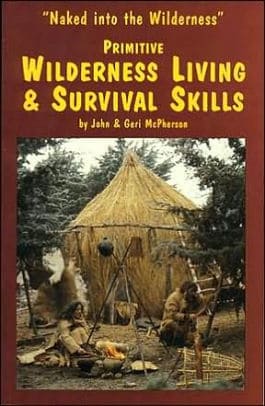 Product Description: G. Fred Asbell is a traditional archery guru with both longbows and recurves and in this book, Instinctive Shooting Volume 2 he takes you on a journey. A journey leading you to become the best traditional archery shooter you can be. Every nuance of the shot sequence is covered in the easy to understand style that has made G. Fred Asbell so popular among traditional bowhunters everywhere. Entire chapters are dedicated to dissecting and describing each step in the shot process. Learn the basic elements described in this book, implement them, and you'll become the accurate shooter you've always wanted to be. Instinctive Shooting Volume 2 is a traditional bowhunting classic. Generously illustrated, 153 pages. Soft cover.
Product Description: G. Fred Asbell is a traditional archery guru with both longbows and recurves and in this book, Instinctive Shooting Volume 2 he takes you on a journey. A journey leading you to become the best traditional archery shooter you can be. Every nuance of the shot sequence is covered in the easy to understand style that has made G. Fred Asbell so popular among traditional bowhunters everywhere. Entire chapters are dedicated to dissecting and describing each step in the shot process. Learn the basic elements described in this book, implement them, and you'll become the accurate shooter you've always wanted to be. Instinctive Shooting Volume 2 is a traditional bowhunting classic. Generously illustrated, 153 pages. Soft cover.- Learn how to shoot accurately
- Covers every aspect of longbow & Recurve shooting
- 153 pages, soft cover by G. Fred Asbell
-
Sale!Out of stock
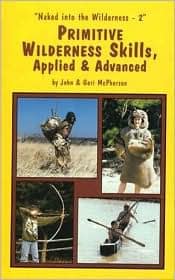 Product Description: "The authors live their subject, and their text is full of practical, tested advice for living off the land." – Sports Afield, Winter 1997-98. This book takes those skills from the first book and applies them in daily primitive living situations. Covers subjects such as:
Product Description: "The authors live their subject, and their text is full of practical, tested advice for living off the land." – Sports Afield, Winter 1997-98. This book takes those skills from the first book and applies them in daily primitive living situations. Covers subjects such as:- Nutrition
- Brain Tanning Robes and Furs
- Dugout Canoe
- Flintknapping
- Bone Needle
- Quick Ax Hafting
- The Quickie Bow
- Water Containers
- Two Piece Moccasins
-
Sale!
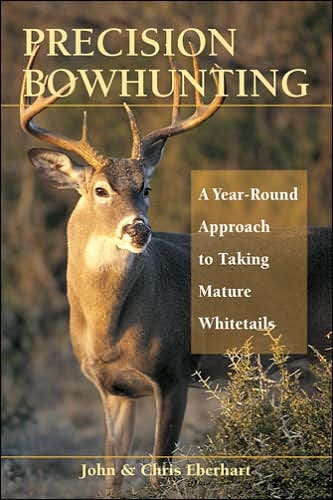 Product Description: • Another must-have title from the authors of the bestselling Bowhunting Pressured Whitetails • Lays out a hunting program for the entire year, including preparation and training during the off-season • Especially useful for hunting high-pressure areas and it explains how to best take advantage of the rut Father-and-son team John and Chris Eberhart have joined once again to share cutting-edge information and advice on hunting whitetail bucks in increasingly hard-hunted environments. Their year-long program starts early in the off-season, where careful scouting, training, and planning create the foundation for a successful hunting year. Then, once the fall rolls around, the authors explain the scent control and scouting tactics that have helped them to bag trophy bucks in some of the most pressured parts of the country. They also cover hunting in the rain, suburban hunting, and various other special situations. Packed with vital information and fresh insights, Precision Bowhunting belongs on the bookshelf of every serious bowhunter. About the Author: John Eberhart is an experienced whitetail deer hunter from the heavily hunted state of Michigan, where he has twenty-one state record bucks. His articles have appeared in Deer & Deer Hunting, Woods-n-Water, and Michigan Out-of-Doors. Chris Eberhart has hunted across the U.S. and Canada and is the author of numerous hunting articles.
Product Description: • Another must-have title from the authors of the bestselling Bowhunting Pressured Whitetails • Lays out a hunting program for the entire year, including preparation and training during the off-season • Especially useful for hunting high-pressure areas and it explains how to best take advantage of the rut Father-and-son team John and Chris Eberhart have joined once again to share cutting-edge information and advice on hunting whitetail bucks in increasingly hard-hunted environments. Their year-long program starts early in the off-season, where careful scouting, training, and planning create the foundation for a successful hunting year. Then, once the fall rolls around, the authors explain the scent control and scouting tactics that have helped them to bag trophy bucks in some of the most pressured parts of the country. They also cover hunting in the rain, suburban hunting, and various other special situations. Packed with vital information and fresh insights, Precision Bowhunting belongs on the bookshelf of every serious bowhunter. About the Author: John Eberhart is an experienced whitetail deer hunter from the heavily hunted state of Michigan, where he has twenty-one state record bucks. His articles have appeared in Deer & Deer Hunting, Woods-n-Water, and Michigan Out-of-Doors. Chris Eberhart has hunted across the U.S. and Canada and is the author of numerous hunting articles. -
Sale!Out of stock
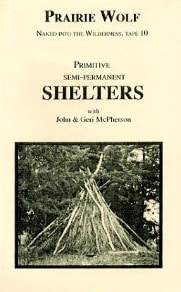 Product Description: One of the most basic of wilderness living and survival skills, the building of a shelter takes on many forms. In this book noted primitive skills instructors John & Geri McPherson illustrate the making of not just quickie overnight survival shelters but what has been in the past real houses for our ancestors. They describe just what a shelter is, what for it's purpose and why. Four shelters are built - each from natural materials commonly found throughout the world; sticks, grasses, rocks, sod - and more. Location is discussed, frameworks built and walls and roofs constructed. All protect you from the rain and allow interior fires. Every stage is shown and explained in detail.
Product Description: One of the most basic of wilderness living and survival skills, the building of a shelter takes on many forms. In this book noted primitive skills instructors John & Geri McPherson illustrate the making of not just quickie overnight survival shelters but what has been in the past real houses for our ancestors. They describe just what a shelter is, what for it's purpose and why. Four shelters are built - each from natural materials commonly found throughout the world; sticks, grasses, rocks, sod - and more. Location is discussed, frameworks built and walls and roofs constructed. All protect you from the rain and allow interior fires. Every stage is shown and explained in detail. -
Sale!Out of stock
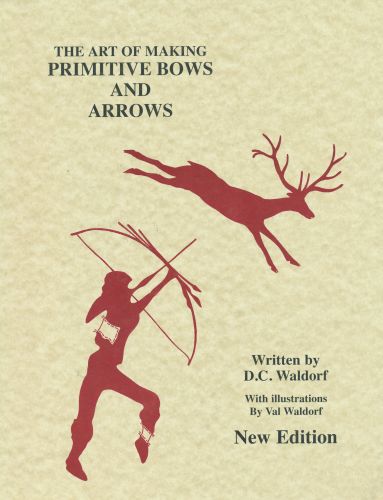 Product Description: Now you can learn how to design and cast flatbows, recurves, self bows and other primitive archery equipment. Includes great information on quivers, arrow making, and more. 52 pages, 92 illustrations. By D. C. Waldorf. New Edition. Subjects Covered:
Product Description: Now you can learn how to design and cast flatbows, recurves, self bows and other primitive archery equipment. Includes great information on quivers, arrow making, and more. 52 pages, 92 illustrations. By D. C. Waldorf. New Edition. Subjects Covered:- Making a simple selfbow
- Design flatbows, recurves, self bows and more
- Sinew backing
- Snakeskins, handle covers and finishes
- Bow strings
- Information on quivers, arrow making and more
- 52 pages with 92 illustrations
-
Sale!Out of stock
 Product Description: Content: This book is meant to be understandable and fun to use. The topics range from the beginnings to the end - cutting and curing wood through building a selfbow of almost any type and finishing it. Both beginners and advanced bowyers should find the book useable and worthwhile. There are extensive descriptions and directions throughout, supported by over 200 color illustrations. Besides the how-to directions, there are sections on heat-bending, splicing billets, shaping handles, and treating problems like knots and cracks; suggestions on how to make a bow with only a few measurements, reduce handstock, eliminate stack, stabilize arrow flight, shoot where you look, and increase arrow speed.
Product Description: Content: This book is meant to be understandable and fun to use. The topics range from the beginnings to the end - cutting and curing wood through building a selfbow of almost any type and finishing it. Both beginners and advanced bowyers should find the book useable and worthwhile. There are extensive descriptions and directions throughout, supported by over 200 color illustrations. Besides the how-to directions, there are sections on heat-bending, splicing billets, shaping handles, and treating problems like knots and cracks; suggestions on how to make a bow with only a few measurements, reduce handstock, eliminate stack, stabilize arrow flight, shoot where you look, and increase arrow speed. -
Sale!Out of stock
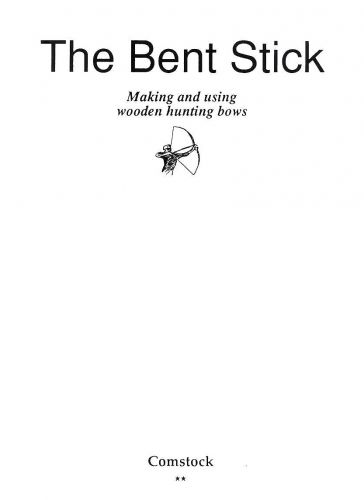 Product Description: Paul Comstock, the author, is a renowned bowyer from Delaware, Ohio, and is highly sought after as an expert in his field. He has also written articles for a number of magazines including Primitive Archer. Paul knows making wooden bows is more art than science. The techniques delineated in his book will produce the best results for the beginner under the most common circumstances and in the widest variety of conditions. Subjects Covered: • Instructions on 10 species of bow wood • How to season wood rapidly • Evaluating wood species for bows • Bow performance • Longbows and short bows • Straight and re-curved limbs • Backing • Shooting techniques • Arrows and primitive arrows. From the Preface: "As much as anything else, "The Bent Stick" is designed to demonstrate the thinking process used in making wooden bows. Read it through before you start work on a bow. And when you do start work on a bow, spend as much time thinking about what you are doing as you spend on the work itself.": "But there is a sizable group of people who could not or did not make a bow until they read "The Bent Stick." Much trial and error has been eliminated for others. I hope this text helps you, as well." Your friend, Paul Comstock
Product Description: Paul Comstock, the author, is a renowned bowyer from Delaware, Ohio, and is highly sought after as an expert in his field. He has also written articles for a number of magazines including Primitive Archer. Paul knows making wooden bows is more art than science. The techniques delineated in his book will produce the best results for the beginner under the most common circumstances and in the widest variety of conditions. Subjects Covered: • Instructions on 10 species of bow wood • How to season wood rapidly • Evaluating wood species for bows • Bow performance • Longbows and short bows • Straight and re-curved limbs • Backing • Shooting techniques • Arrows and primitive arrows. From the Preface: "As much as anything else, "The Bent Stick" is designed to demonstrate the thinking process used in making wooden bows. Read it through before you start work on a bow. And when you do start work on a bow, spend as much time thinking about what you are doing as you spend on the work itself.": "But there is a sizable group of people who could not or did not make a bow until they read "The Bent Stick." Much trial and error has been eliminated for others. I hope this text helps you, as well." Your friend, Paul Comstock -
Sale!
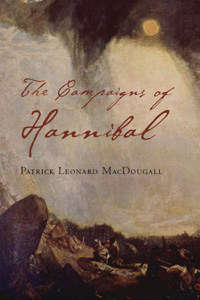 The great Carthaginian general, Hannibal, remains one of the most fascinating personalities of the ancient world. Most are familiar with his famous trek across the Alps, complete with elephants and an army of tens of thousands, but fewer understand that the Carthaginian clash with Rome during the third century B.C. was a war between two mighty regional powers that would define the future of Mediterranean world. The victor of the Punic Wars would determine whether the focus would be on North Africa or along the Italian Peninsula. The Campaigns of Hannibal begins with an account of the organization, weapons, and chief tactics of both the Romans and Carthaginians, and then proceeds in chronological order through the thirteen campaigns waged by Hannibal against Rome over the course of 218–207 B.C., including the battles of Trebbia and Cannae. After each campaign, the author discusses the salient points that students of strategy and the history of warfare should recognize. The book concludes with Hannibal's return to North Africa, his final defeat at Zama in 203 B.C., his subsequent exile and death. Based on classical sources and originally published in 1858, The Campaigns of Hannibal is a model of clarity and synthesis, a wonderful one-volume history that is ideal for those who wish to learn more about Hannibal's military genius as well as those seeking a synopsis of the Punic Wars. Sir Patrick Leonard MacDougall (1819–1894) was a military officer and author. He was commander of British troops in North America from 1878 to 1883. 10 maps, 216 pages, Trade Paperback
The great Carthaginian general, Hannibal, remains one of the most fascinating personalities of the ancient world. Most are familiar with his famous trek across the Alps, complete with elephants and an army of tens of thousands, but fewer understand that the Carthaginian clash with Rome during the third century B.C. was a war between two mighty regional powers that would define the future of Mediterranean world. The victor of the Punic Wars would determine whether the focus would be on North Africa or along the Italian Peninsula. The Campaigns of Hannibal begins with an account of the organization, weapons, and chief tactics of both the Romans and Carthaginians, and then proceeds in chronological order through the thirteen campaigns waged by Hannibal against Rome over the course of 218–207 B.C., including the battles of Trebbia and Cannae. After each campaign, the author discusses the salient points that students of strategy and the history of warfare should recognize. The book concludes with Hannibal's return to North Africa, his final defeat at Zama in 203 B.C., his subsequent exile and death. Based on classical sources and originally published in 1858, The Campaigns of Hannibal is a model of clarity and synthesis, a wonderful one-volume history that is ideal for those who wish to learn more about Hannibal's military genius as well as those seeking a synopsis of the Punic Wars. Sir Patrick Leonard MacDougall (1819–1894) was a military officer and author. He was commander of British troops in North America from 1878 to 1883. 10 maps, 216 pages, Trade Paperback -
Sale!
 A period of stability in the early sixth century AD gave the Eastern Roman emperor Justinian an opportunity to recapture parts of the Western Empire which had been lost to invading barbarians in the preceding centuries. It was an ambitious plan to attack such a vast territory with relatively few soldiers and resources. Yet Justinian’s army succeeded in checking the Persians in the East and in retaking North Africa from the Vandals and Italy from the Ostrogoths, the strongest and most organized Barbarian tribe in the West. The climactic conflict over Italy between 535 and 554—the Gothic War—decided the political future of Europe, holding in its balance the possibility that the Roman Empire might rise again. While large portions of the original territory of the ancient Roman Empire were recaptured, the Eastern Empire was both unwilling and incapable of retaining much of its hard-won advances, and soon the empire once again retracted. As a result of the Gothic War, Italy was invaded by the Lombards who began their important kingdom, the Franks began transforming Gaul into France, and without any major force remaining in North Africa, that territory was quickly overrun by the first wave of Muslim expansion in the ensuing century. Written as a general overview of this critical period, The Gothic War opens with a history of the conflict with Persia and the great Roman general Belisarius’s successful conquest of the Vandals in North Africa. After an account of the Ostrogothic tribe and their history, the campaigns of the long war for Italy are described in detail, including the three sieges of Rome, which turned the great city from a bustling metropolis into a desolate ruin. In addition to Belisarius, the Gothic War featured many of history’s most colorful antagonists, including Rome’s Narses the Eunuch, and the Goths’ ruthless and brilliant tactician, Totila. Two appendices provide information about the armies of the Romans and Ostrogoths, including their organization, weapons, and tactics, all of which changed over the course of the war. TORSTEN CUMBERLAND JACOBSEN is a former curator of the Royal Danish Military Museum.
A period of stability in the early sixth century AD gave the Eastern Roman emperor Justinian an opportunity to recapture parts of the Western Empire which had been lost to invading barbarians in the preceding centuries. It was an ambitious plan to attack such a vast territory with relatively few soldiers and resources. Yet Justinian’s army succeeded in checking the Persians in the East and in retaking North Africa from the Vandals and Italy from the Ostrogoths, the strongest and most organized Barbarian tribe in the West. The climactic conflict over Italy between 535 and 554—the Gothic War—decided the political future of Europe, holding in its balance the possibility that the Roman Empire might rise again. While large portions of the original territory of the ancient Roman Empire were recaptured, the Eastern Empire was both unwilling and incapable of retaining much of its hard-won advances, and soon the empire once again retracted. As a result of the Gothic War, Italy was invaded by the Lombards who began their important kingdom, the Franks began transforming Gaul into France, and without any major force remaining in North Africa, that territory was quickly overrun by the first wave of Muslim expansion in the ensuing century. Written as a general overview of this critical period, The Gothic War opens with a history of the conflict with Persia and the great Roman general Belisarius’s successful conquest of the Vandals in North Africa. After an account of the Ostrogothic tribe and their history, the campaigns of the long war for Italy are described in detail, including the three sieges of Rome, which turned the great city from a bustling metropolis into a desolate ruin. In addition to Belisarius, the Gothic War featured many of history’s most colorful antagonists, including Rome’s Narses the Eunuch, and the Goths’ ruthless and brilliant tactician, Totila. Two appendices provide information about the armies of the Romans and Ostrogoths, including their organization, weapons, and tactics, all of which changed over the course of the war. TORSTEN CUMBERLAND JACOBSEN is a former curator of the Royal Danish Military Museum. -
Sale!
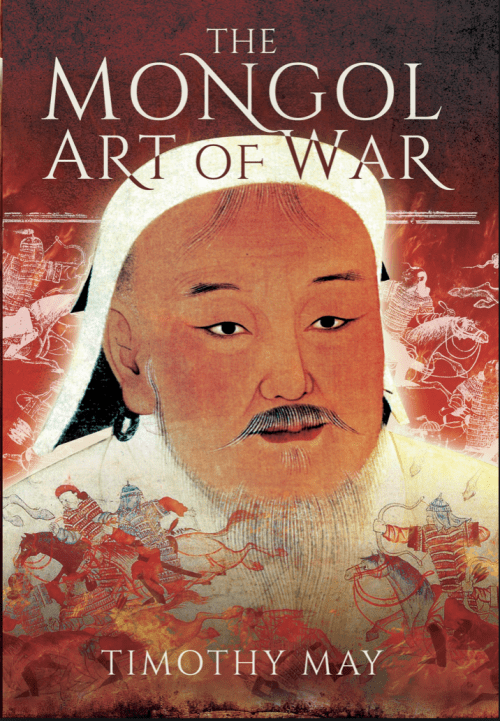 "An authoritative study of one of history's most feared and successful armies. . . . May concludes this definitive study by tracing the Mongol legacy to modern mechanized warfare." - Publishers Weekly "They razed cities to the ground, burnt woods, pulled down castles, tore up the vine trees, destroyed gardens, and massacred the citizens and husbandmen; if by chance they did spare any who begged their lives, they compelled them, as slaves of the lowest condition, to fight in front of them against their own kindred." - Matthew Paris recounting the devastation of Poland and Hungary in 1240 During the thirteenth century, Mongol armies under Chinggis Khan and his successors established the largest contiguous land empire in history, stretching across Asia and into eastern Europe. Contemporary descriptions of their conquests have led to a popular misconception that the Mongols were an undisciplined horde of terrifying horsemen who swept over opponents by sheer force of numbers. The Mongol army actually used highly trained regiments led by brilliant tacticians, such as Subutai, that carried out planned and practiced maneuvers. It was the strength, quality, and versatility of the Mongol military organization, not unchecked ferocity, that made them the pre-eminent warriors of their time. In The Mongol Art of War, historian Timothy May overturns myths and misunderstandings that distort our understanding of Mongol warfare, and demonstrates that the armies of Chinggis Khan had more in common with modern ones than with the armies of ancient Rome and those of the medieval kingdoms they confronted. Describing the make-up of the Mongol army from its inception to the demise of the Mongol Empire, the author examines the recruitment, weaponry, and training of the Mongol warrior. He also analyzes the organization, tactics, and strategies the Mongols used, how they adapted to fighting in different conditions and terrain - such as using harsh winter weather to their advantage - and overcame a variety of opponents by steadily changing and adopting new tactics and modes of combat. Timothy May, a leading expert on the Mongol empire, is a professor of history at North Georgia College and State University. Illustrated 30 b/w / 232 pages / Jacketed Hardback
"An authoritative study of one of history's most feared and successful armies. . . . May concludes this definitive study by tracing the Mongol legacy to modern mechanized warfare." - Publishers Weekly "They razed cities to the ground, burnt woods, pulled down castles, tore up the vine trees, destroyed gardens, and massacred the citizens and husbandmen; if by chance they did spare any who begged their lives, they compelled them, as slaves of the lowest condition, to fight in front of them against their own kindred." - Matthew Paris recounting the devastation of Poland and Hungary in 1240 During the thirteenth century, Mongol armies under Chinggis Khan and his successors established the largest contiguous land empire in history, stretching across Asia and into eastern Europe. Contemporary descriptions of their conquests have led to a popular misconception that the Mongols were an undisciplined horde of terrifying horsemen who swept over opponents by sheer force of numbers. The Mongol army actually used highly trained regiments led by brilliant tacticians, such as Subutai, that carried out planned and practiced maneuvers. It was the strength, quality, and versatility of the Mongol military organization, not unchecked ferocity, that made them the pre-eminent warriors of their time. In The Mongol Art of War, historian Timothy May overturns myths and misunderstandings that distort our understanding of Mongol warfare, and demonstrates that the armies of Chinggis Khan had more in common with modern ones than with the armies of ancient Rome and those of the medieval kingdoms they confronted. Describing the make-up of the Mongol army from its inception to the demise of the Mongol Empire, the author examines the recruitment, weaponry, and training of the Mongol warrior. He also analyzes the organization, tactics, and strategies the Mongols used, how they adapted to fighting in different conditions and terrain - such as using harsh winter weather to their advantage - and overcame a variety of opponents by steadily changing and adopting new tactics and modes of combat. Timothy May, a leading expert on the Mongol empire, is a professor of history at North Georgia College and State University. Illustrated 30 b/w / 232 pages / Jacketed Hardback -
Sale!Out of stock
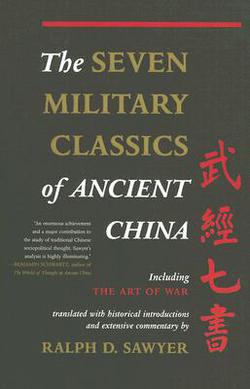 One of the most profound studies of warfare ever written, The Seven Military Classics of Ancient China presents us with an Eastern tradition of strategic thought that emphasizes outwitting one’s opponent through speed, stealth, flexibility, and a minimum of force-an approach very different from that stressed in the West, where the advantages of brute strength have overshadowed more subtle methods. Safeguarded for centuries by the ruling elites of imperial China, even in modern times these writings have been known to only a handful of Western specialists. In this volume are seven separate essays, written between 500 B.C. and A.D. 700, that preserve the essential tenets of strategy distilled from the experience of the most brilliant warriors of ancient China. This accurate translation remedies a serious gap in Western knowledge of Asian thought. Based on the best available classical Chinese manuscripts, some only recently discovered by archaeologists, The Seven Military Classics of Ancient China is a uniquely important contribution to the world’s military literature and is essential reading for anyone interested in China’s rich cultural heritage or in the timeless principles of successful warfare strategy. Paperback
One of the most profound studies of warfare ever written, The Seven Military Classics of Ancient China presents us with an Eastern tradition of strategic thought that emphasizes outwitting one’s opponent through speed, stealth, flexibility, and a minimum of force-an approach very different from that stressed in the West, where the advantages of brute strength have overshadowed more subtle methods. Safeguarded for centuries by the ruling elites of imperial China, even in modern times these writings have been known to only a handful of Western specialists. In this volume are seven separate essays, written between 500 B.C. and A.D. 700, that preserve the essential tenets of strategy distilled from the experience of the most brilliant warriors of ancient China. This accurate translation remedies a serious gap in Western knowledge of Asian thought. Based on the best available classical Chinese manuscripts, some only recently discovered by archaeologists, The Seven Military Classics of Ancient China is a uniquely important contribution to the world’s military literature and is essential reading for anyone interested in China’s rich cultural heritage or in the timeless principles of successful warfare strategy. Paperback